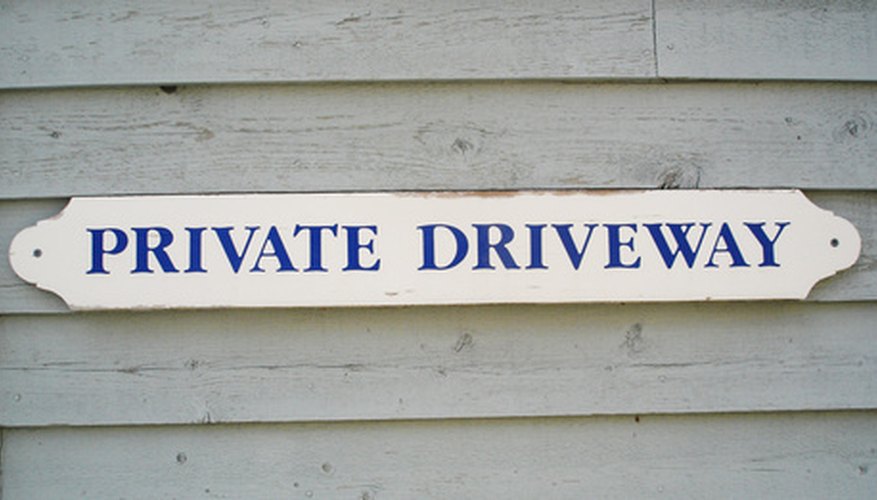Over time, asphalt driveways will begin to crack and crumble. Repairing a crumbling drive can be a daunting task, and it will take considerable time and patience. As long as you follow the steps closely, the new drive should look professional, and the crumbling one will be a distant memory.
Repair cracks
Dig away the loose chunks of asphalt and any broken materials near the cracks with either a wire brush or masonry chisel.
Sweep the loose materials out of the crack using a stiff-bristled broom. Alternatively, you can vacuum the cracks with your hand-held vacuum.
- Dig away the loose chunks of asphalt and any broken materials near the cracks with either a wire brush or masonry chisel.
- Sweep the loose materials out of the crack using a stiff-bristled broom.
Clean off the dust from the area, using the garden hose with the pressure nozzle. If there is a lot of oil and grease, or if the area is otherwise badly soiled, scrub the area with a strong driveway cleaning agent. For the patch to adhere, it is very important for the cracks to be completely clean.
Apply the filler once the cracks are completely clean.
Fill depressed areas
Clean the depressed areas -- small dips that cause water puddles to develop in the driveway. They must be clean first before you fill them. Sweep away any dirt or use the pressure nozzle on the hose to spray away grease or oil. Use a detergent or cleaner if the materials won't come off with the hose.
- Clean the depressed areas -- small dips that cause water puddles to develop in the driveway.
- Use a detergent or cleaner if the materials won't come off with the hose.
Apply the patching material to the depressed areas, taking great care to ensure that there is no standing water. It is OK if the surface is slightly damp.
Prime the areas you have just patched with emulsified liquid asphalt. Priming will help ensure that the new material will adhere to the materials already on the drive.
Fill the depressed areas. Using a trowel, carefully spread the asphalt cold-patching material into any depressions, making sure to fill it level to the surrounding surfaces. Make sure the patch is smooth, and then use a metal tamper to tamp it.
Allow the patches to dry for 24 hours before moving on to another step.
Patch potholes
Create a solid base by removing dirt and other loose materials in the chuckholes until you have reached solid ground.
- Create a solid base by removing dirt and other loose materials in the chuckholes until you have reached solid ground.
Clean the area of any dust, dirt or debris from around the hole and the surroundings.
Prime the area, using the emulsified asphalt liquid. Priming will help the old and new material to bond together.
Place cold patch material in the hole to a depth of 5 cm (2 inches). Tamp the material firmly or use a garden roller to roll it out. Continue adding the cold patch material 5 cm (2 inches) at a time. When you have filled the hole to within 2.5 cm (1 inch) of the top, add one more 5 cm (2 inch) layer of the cold patch material. This will fill the hole completely and leave it mounded slightly. Tamp the material down as firmly as possible. For the best results, run back and forth over the material with your car tyres.
Fill in low areas with any remaining cold patch material to make these areas even with the rest of the drive.
Allow the area to cure for 12 to 36 hours before driving over it and two to five days before sealing the drive.
Seal the drive
Clean the surface of any oil, dirt, grease and other debris. Using your broom, sweep up as much as you can. Using a cleaner or detergent, wash the area to remove any grease or dirt spots that the broom didn't get up. Rinse the drive immediately with a hose and pressure nozzle, and use a squeegee to remove water from any puddled spots. It is OK if the area is not completely dry before applying the sealant.
- Clean the surface of any oil, dirt, grease and other debris.
- Using a cleaner or detergent, wash the area to remove any grease or dirt spots that the broom didn't get up.
Stir the sealant thoroughly to ensure that all the ingredients are blended together properly.
Apply the sealant to small sections of the drive. Using a squeegee or roller, spread the sealant around evenly. Allow smaller cracks or areas that are extremely weathered to soak in the sealant.
Erect barriers in front of the drive. It is very important that the sealant be allowed to cure for 24 hours before vehicles come into the driveway.
TIP
If the drive is on a sloped area, you can add dry sand to the sealant mix to improve traction.
